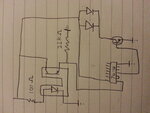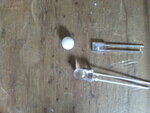3dprintingtech
Newbie level 5

Now I'm no electronic wizard so bear with me.
I have mad a small circuit designed to detect when a BB gun is firing and flash a small led on the side of the BB gun to let you know its firing (and still have ammo).
I used these RX and TX led's from maplin as a detection (CH11M, CH10L) the signal goes through a 74HCT14N HCT CMOS then a 2n3906 transistor.
The Problem being: When a BB is dropped through the detector the led flashes (i have also flicked them to make it move a little quicker) so I thought it was all working. When I fire a BB at aprox 330 feet per second it does not detect it and the led does not flash.
it would appear that the rx and tx led does not detect fast enough.
now the BB is 6mm Dia and can travel at a max of 500FPS or 152.4 m/s.
I think the optics need changing but im not sure what maths is required or what I need to look at.
Any pointers please all.
(below is my circuit layout)

I have mad a small circuit designed to detect when a BB gun is firing and flash a small led on the side of the BB gun to let you know its firing (and still have ammo).
I used these RX and TX led's from maplin as a detection (CH11M, CH10L) the signal goes through a 74HCT14N HCT CMOS then a 2n3906 transistor.
The Problem being: When a BB is dropped through the detector the led flashes (i have also flicked them to make it move a little quicker) so I thought it was all working. When I fire a BB at aprox 330 feet per second it does not detect it and the led does not flash.
it would appear that the rx and tx led does not detect fast enough.
now the BB is 6mm Dia and can travel at a max of 500FPS or 152.4 m/s.
I think the optics need changing but im not sure what maths is required or what I need to look at.
Any pointers please all.
(below is my circuit layout)





